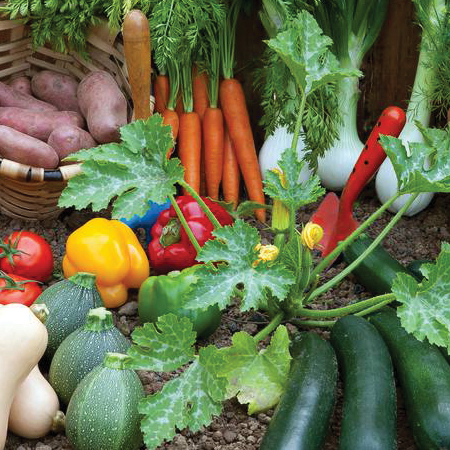Most vegetables are at their peak of tenderness and flavor when they are relatively small. Zucchini, for example, are best when they are no more than six or seven inches long. Then they get tough and woody. (If you discover an overlooked whopper, grate it and make zucchini cookies or zucchini bread.)But it’s crucial to keep track of what you planted and keep the seed packet so you know what to expect. There are many cultivars of vegetables today, bred for different characteristics such as size. You can plant a watermelon variety that ripens at eight inches across (see here) or one that’s not ready until the fruit weighs 30 pounds. And it would be a shame to pick yardlong beans (which actually are best when they are 15 to 18 inches long) at the five to six inches that would be normal for pole beans.When you harvest, look out for signs of trouble, such as yellowing leaves or rotting fruit, and remove the problem parts. Even if it’s something you can do little about — such as blossom end rot or cracking from too much rain — there’s no point in letting the plant put energy into fruit you won’t be able to eat.
Here are some tips for harvesting some common vegetable-garden bounty:
Herbs. Pinch or cut back herbs frequently to keep them producing more stems and leaves (the parts we eat) and to keep them from blooming, which changes the flavor. If that means you have surplus thyme or oregano, dry it in a brown paper bag. Basil, especially, needs frequent pinching back to keep it bushy and productive. At some point in July or August everybody has too much basil, which is why the Italians invented pesto (find many recipes on the internet).Tomatoes. There is a huge range of tomato varieties. Many kinds are red when ripe, but some are orange, yellow, striped or even green. You can plant tiny currants or huge slicers which will usually take more time to ripen. So learn what to expect from your variety and monitor the plant closely as its due date nears. Generally, a tomato is fully ripe when it releases easily from the stem. If you misjudge a bit it’s no tragedy, because tomatoes will ripen somewhat after picking. But they develop the fullest sweet flavor if they ripen in the sun on the vine. Once you have picked the first few tomatoes of a particular variety, you will get a feel for what a ripe one will look and taste like. Some tomatoes are “determinate” types, which will stop bearing after a few weeks. Most are “indeterminate” kinds, which will keep flowering and setting fruit until killed by frost, although colder weather will slow production. It’s a good idea to pick your green tomatoes a week or so before your area’s average first frost date. The more mature ones will ripen indoors if they are stored at room temperature, wrapped in newspaper so they don’t touch. Or make fried green tomatoes.
Peppers. Peppers are mature and ready to eat when full-sized but still green. If left on the vine longer, they will change color to red, orange, yellow or brown, depending on the variety, and will deepen in flavor and become less crisp in texture. Hot peppers left to change color will get hotter. So whether you pick at the green stage or later will depend on the variety and what you plan to use the pepper for. As with tomatoes, the first few you pick will teach you to gauge ripeness.
Lettuce. It’s important to pick lettuce before hot weather encourages the plant to “bolt,” or develop a flower stalk, which makes the leaves taste bitter. With leaf lettuce and many other greens, you can “cut and come again” while the leaves are young and tender, no more than five inches long. Use scissors to cut the largest leaves individually from the plants. When the smaller leaves get big enough, harvest those. You may be able to come back to a plant two, three or four times, a few days apart, before it gives up in the summer heat. To prolong the lettuce harvest, look for bolt-resistant varieties and sow seeds several times at two-week intervals. A tent of shade cloth or translucent row cover — or a site in part shade — also may delay bolting in hot climates. In late summer, sow green seeds again for a fall crop.
Green beans. Pick the pods when they are a little shy of their maximum size, to be sure that they are tender, with immature seeds. If you delay, the seeds will mature and harden and the pod will become tough. Don’t pick green beans in the morning when the dew is still on the vines; wait until they are fully dry to avoid spreading disease. And keep up with the picking to encourage the vine to keep flowering and producing pods.
Peas. For garden peas, pick a test pod and open it when the seeds have begun to swell inside. You’re looking for peas that are round but still tender. Pick peas just before you are ready to shell and cook them. For snow peas and sugar snaps, taste a pod when it nears full size. You want a crisp, crunchy, fresh-tasting pod, in which the seeds have started developing but are nowhere near round. Pods left too long on the vine get tough and stringy.
Cantaloupes, muskmelons and honeydews: Melons are tricky, even for melon farmers. You can thump the melon and listen for a dull, hollow sound or sniff it to see if it smells sweet. A ripe cantaloupe or muskmelon will begin to have a tan or yellowish color beneath the corky “netting” on its skin. A honeydew will feel smooth, not hairy. Cut the stem rather than breaking the fruit off, which creates a wound that invites the fruit to rot. Let the fruit ripen for another day or two at room temperature before cutting into it.
Watermelons. When the spot beneath the melon, where it sits on the ground, turns yellowish, rather than white or green, the melon is close to ripe. The rind also gets tougher, so test it with your thumbnail to how easily it dents. For old-fashioned full-sized watermelons, the traditional ripeness test is to thump and listen for a dull, hollow sound, but this may not work as well with the smaller “icebox” varieties. Ultimately, you’ll have to cut one open and decide if it’s ripe, and use that as a standard for the rest of the crop.
Cucumbers. Check the seed packet to see how large your variety of cucumber will get and how long that is expected to take. But bear in mind that you can pick cucumbers at any stage, depending on what you want to use them for. Smaller ones will be more tender, with thinner skins and few or immature seeds. Too-old cucumbers get dry and woody. Like melons, cucumbers should be cut from the vine, not pulled.
Sweet corn. Timing is everything with sweet corn. The kernels begin to lose sweetness and flavor the instant the ear is picked, so the great advantage of growing your own is so you can wait until the last minute. The traditional rule was to get the pot of water boiling to cook the corn and then go out and pick it. Sweet corn is ready to eat when you can feel full, rounded kernels beneath the husk; the silk at the top of the ear is drying out; and a squished kernel produces a milky sap.
Root vegetables. Read the seed packet to see how long it should take before you start checking to see if your variety of carrots, beets, turnips, radishes or parsnips is ready. When it’s about time, loosen the soil gently and pull one up to see how big it is. Root vegetables are more tender and delicate in flavor if eaten younger and smaller; as they get older and larger, they get tougher, woodier and more pungent. If that’s okay with you, you can store some root crops right in the cold ground after the tops die. Spread a thick layer of leaves, straw or other mulch to keep the ground from freezing so you can still dig them up, and you may be able to harvest carrots, turnips or parsnips at Thanksgiving.


